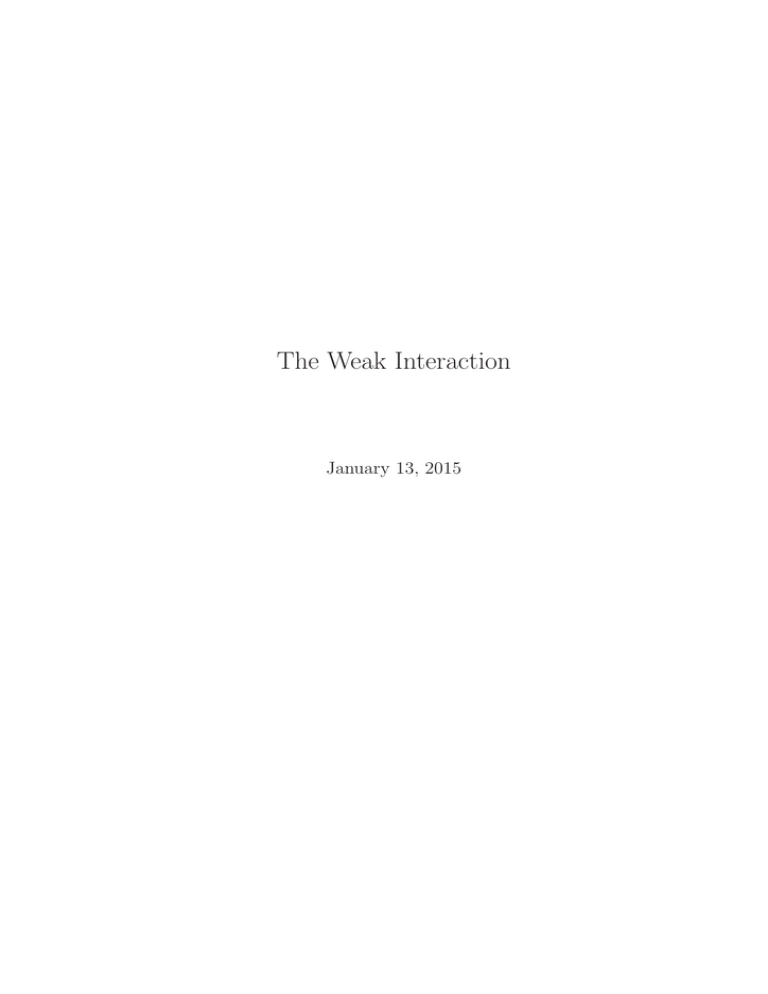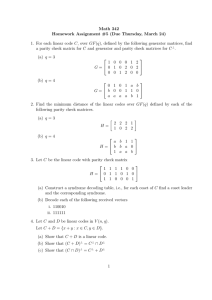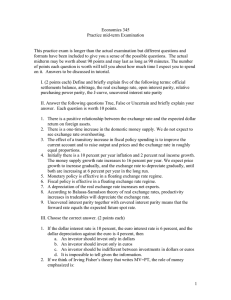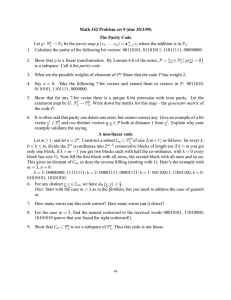The Weak Interaction January 13, 2015
advertisement

The Weak Interaction
January 13, 2015
0.1
Introduction
The nuclear β-decay caused a great deal of anxiety among physicists. Both α- and γ-rays are emitted
with discrete spectra, simply because of energy conservation. The energy of the emitted particle is
the same as the energy difference between the initial and final state of the nucleus. It was much
more difficult to see what was going on with the β-decay, the emission of electrons from nuclei.
Chadwick once reported that the energy spectrum of electrons is continuous. The energy could take
any value between 0 and a certain maximum value. This observation was so bizarre that many more
experiments followed up. In fact, Otto Han and Lise Meitner, credited for their discovery of nuclear
fission, studied the spectrum and claimed that it was discrete. They argued that the spectrum may
appear continuous because the electrons can easily lose energy by breamsstrahlung in material. The
maximum energy observed is the correct discrete spectrum, and we see lower energies because of the
energy loss. The controversy went on over a decade. In the end a definitive experiment was done
by Ellis and Wooseley using a very simple idea. Put the β-emitter in a calorimeter. This way, you
can measure the total energy deposit. They demonstrated that the total energy was about a half of
the maximum energy on average. The spectrum is indeed continuous. The fact that the β-spectrum
is continuous was so puzzling to people, even inspiring Niels Bohr to say “At the present stage of
atomic theory, however, we may say that we have no argument, either empirical or theoretical, for
upholding the energy principle in the case of β-ray disintegrations”. He was ready to give up the
energy conservation! This quote shows how desperate people were.
The solution to the problem was devised by Pauli. In 1930, he wrote a letter to colleagues attending
a meeting at Tubingen. Here is a quote from his letter: 4th December 1930
Dear Radioactive Ladies and Gentlemen, As the bearer of these lines, to whom I gracious
ask you to listen, will explain to you in more detail, how because of the "wrong" statist
of the N and Li6 nuclei and the continuous beta spectrum, I have hit upon a desperate
remedy to save the "exchange theorem" of statistics and the law of conservation of energy
Namely, the possibility that there could exist in the nuclei electrically neutral particl
that I wish to call neutrons, which have spin 1/2 and obey the exclusion principle and
which further differ from light quanta in that they do not travel with the velocity of
light. The mass of the neutrons should be of the same order of magnitude as the electron
mass and in any event not larger than 0.01 proton masses. The continuous beta spectrum
would then become understandable by the assumption that in beta decay a neutron is emitte
in addition to the electron such that the sum of the energies of the neutron and the
electron is constant...
Pauli’s “neutron” became our neutrino and the process of β-decay became
n → p + e− + νe
0.2
(1)
The Weak Interaction
The weak interaction is responsible for radioactive decays. It is characterised by long lifetimes, and
small cross sections. All fermions feel the weak interaction. When present, though, strong and
electromagnetic interactions dominate.
Of special note are the neutrinos. Neutrinos feel only the weak interaction, which is what makes
1
them so difficult to study. They are the only particles to experience just one of the fundamental
forces.
Figure 1: Lifetime of various decays. The strong decays are the fastest, followed by the electromagnetic
decays and then the weak decays.
0.2.1
The 4-point Interaction
The first attempt to construct a theory of the weak interaction was made by Fermi in 1932. In analogy
to the electromagnetic interaction, he imagined a 4-point interaction that happened at a single point
in space-time. His idea of β-decay is shown in Figure2
Figure 2: Fermi’s 4-point interaction.
In analogy to the electromagnetic interaction, Fermi proposed the following matrix element
GF
M = √ [uP γ µ uN ][ue γ ν uν ]
2
(2)
We take note of some points here
• Charge changing : The hadronic current has ∆Q = +1, whereas the lepton current has
∆Q = −1. There is net charge transferred from the hadronic to the lepton current and so we
call this a charged current interaction.
2
• Universality : There is a coupling factor, GF , called the Fermi Constant, equal to 1.166 ×
10−5 GeV−2 . Fermi postulated, and is has later been shown to stand up to experiment, that the
weak coupling factor is the same for all weak vertices, regardless of the flavour of lepton taking
part. This is called universality and is an extremely important concept.
• There is no propagator
• The currents have a vector character, purely in analogy to the electromagnetic interaction where
it was known that the currents were vector in nature.
The cross section for the interaction νe +n → p+e− , as generated from Fermi’s 4-point interaction,
was calculate shortly after by Bethe. He found that
σ(n + νe → e− + p) ∼ Eν (MeV ) × 10−43 cm2
(3)
. This is extremely small. You would need about 50 light-years of water to stop one 1 MeV neutrino.
This cross-section also has a problem. It rises linearly with energy ... for ever. This is clearly
incorrect and shows that the Fermi model breaks down at high energies. We need a bit of modification
to the theory. We need to add a propagator.
0.2.2
Weak Propagator
We now know that the weak interaction is mediated by two massive gauge bosons : the charged W ±
and the neutral Z 0 . The propagation term for the massive boson is M 2 1 −q2 . If we assume that
W,Z
the Fermi theory is the low energy limit of the Weak Interaction, then we can estimate the intrinsic
coupling at high energy. In the Fermi limit, the coupling factor appears to G√F2 . At low energies, with
2
MW,Z
>> q 2 , the propagator term reduces to just M12 and we can make the identification
W
GF
g 2
√ = w2
8MW
2
(4)
We’ll see in a minute where the factor of 8 comes from.
g
Coupling ∼
G
√F
2
W
g
Coupling :∼
2
gw
2
8MW
This allows us to compare the intrinsic couplings of the weak interaction with the electromagnetic
interaction. The mass of the W boson is 80.4GeV and the Fermi constant is 1.166 × 10−5 GeV−2 .
3
Plugging this into Equation 4 we get a weak coupling factor of gw = 0.65. Now, remember that the
electromagnetic interaction coupling factor is the square root of the fine structure constant, we have
EM coupling : αEM =
1
137
Weak coupling : αW =
gw2
1
=
4π
30
(5)
In fact the weak interaction is, intrinsically, about 4 times stronger than the electromagnetic
interaction. What makes the interaction so weak is the large mass of the relevant gauge bosons. In
2
fact at very high energies, where q 2 ∼ MW
, the weak interaction is comparable in strength to the
electromagnetic interaction.
How about the high energy behaviour? At high energies the mass of the W-boson supresses the
total cross section and stops it going to infinity. So the propagator solves that issue as well.
0.3
0.3.1
Parity Violation
Parity and The Parity Operator
The parity operation is defined as spatial inversion around the origin :
t′ ≡ t x′ ≡ −x y ′ ≡ −y
z ′ ≡ −z
(6)
Consider a Dirac spinor, ψ(t, x, t, z). A parity transformation would transform this spinor to
P̂ ψ(t, x, y, z) = ψ(t, −x, −y, −z) = ψ ′ (t′ , x′ , y ′, z ′ )
(7)
. We can prove that the relevant operator is actually γ 0 . That is,
ψ ′ (t′ , x′ , y ′ , z ′ ) = ψ(t, −x, −y, −z) = ±γ 0 ψ(t, x, y, z)
(8)
.
Consider a Dirac spinor, ψ(t, x, y, z), that obeys the Dirac equation
iγ 0
∂ψ
∂ψ
∂ψ
∂ψ
+ iγ 1
+ iγ 2
+ iγ 3
− mψ = 0
∂t
∂x
∂y
∂z
(9)
Under the parity transformation : ψ ′ (x′ , y ′, z ′ , t′ ) = P̂ ψ(x, y, z, t) = γ 0 ψ(x, y, z, t). Since (γ 0 )2 = 1,
this implies that
ψ(x, y, z, t) = γ 0 ψ ′ (x′ , y ′, z ′ , t′ )
(10)
Substituting this into the Dirac equation we have
iγ 0 γ 0
∂ψ ′
∂ψ ′
∂ψ ′
∂ψ ′
+ iγ 1 γ 0
+ iγ 2 γ 0
+ iγ 3 γ 0
− mγ 0 ψ ′ = 0
∂t
∂x
∂y
∂z
(11)
We use the chain rule to express the derivative in terms of the primed coordinate system e.g.
∂x′ ∂ψ ′
∂ψ ′
∂ψ ′
=
=
−
∂x
∂x ∂x′
∂x′
since x′ = −x under parity. In the Dirac equation,
4
(12)
iγ 0 γ 0
′
′
′
∂ψ ′
1 0 ∂ψ
2 0 ∂ψ
3 0 ∂ψ
−
iγ
γ
−
iγ
γ
−
iγ
γ
− mγ 0 ψ ′ = 0
′
′
′
′
∂t
∂x
∂y
∂z
(13)
and since γ 0 anticommutes with γ i for i = 1, 2, 3,
i
′
′
′
∂ψ ′
0 1 ∂ψ
0 2 ∂ψ
0 3 ∂ψ
+
iγ
γ
+
iγ
γ
+
iγ
γ
− mγ 0 ψ ′ = 0
′
′
′
′
∂t
∂x
∂y
∂z
(14)
Multiplying on the left by γ 0 , and recalling that (γ 0 )2 = 1, we then get
′
0 ∂ψ
iγ
∂t′
+
′
1 ∂ψ
iγ
∂x′
+
′
2 ∂ψ
iγ
∂y ′
+
′
3 ∂ψ
iγ
∂z ′
− mψ ′ = 0
(15)
which is the Dirac equation in the primed coordinates. Hence, under parity transformations the
Dirac equation is unchanged (as it should be) provided that the bispinors transform as
ψ → P̂ ψ = ±γ 0 ψ
(16)
2
If we apply the parity operator twice then we must return the original wavefunction : P̂ 2 = γ 0 = 1.
The eigenvalues of the parity operator are, therefore, ±1. Hadrons are eigenstates of P̂ . The parity
of a fermion is opposite that of the anti-fermion, whereas the parity of a boson is the same as its antiboson. We arbitrarily take particles to have positive or “even” intrinsic parity, and the anti-particle
(if a fermion) is said to have negative or “odd” parity. The parity of a combined system is the product
of the parity of its constituent parts.
0.3.2
Parity Violation
In 1956, T.D. Lee and C.N. Yang were trying to solve a very puzzling problem called the τ − θ
problem. Two strange mesons, called the τ and the θ, appeared to be identical in every respect :
mass, spin, charge etc. The problem was that the τ was observed to decay into three pions π + π + π −
or π + π 0 π 0 . The other one, the θ , decays into two pions π + π 0 . Both are spin zero particles of
strangeness one. The analysis of the final state showed that the τ decays into a parity odd state,
while the θ into a parity even state. This seems impossible if the two particles were the same. Lee
and Yang, after studying this, pointed out in 1956 that maybe these two particles could be the same
particle. Of course this would be possible only if the parity is not preserved in these decays. They
examined carefully the available evidence for parity conservation, and concluded that there was a lot
of evidence for parity conservation in the strong and the electromagnetic interactions, while there was
none in the weak interaction. They further proposed various ways the parity (non)conservation could
be tested experimentally in the weak interaction.
Almost immediately C.S. Wu devised and carried a beautiful experiment to test the possibility of
parity violation in beta decay. She set up a system of Co 60 atoms which all decayed via β emission to
Ni
60. She aligned them in a magnetic field, so that all their spin vectors lined up and then let them
decay, measuring the direction of the outgoing electron. If parity were conserved, she would expect
to see electrons emitted isotropically. Why? Have a look at Figure 3
The spin vector of the Cobalt atom, labelled as J in the diagram, points to the left in both
this world and the parity transformed mirror world. Suppose an electron were to be omitted in
the direction of the spin vector in this world. In the mirror world the electron will be going in the
other direction, opposite the direction of spin. Parity conservation implies that the probability of one
interaction happening in this world is the same as the probability of it’s mirror image occurring, and
5
Figure 3: A schematic of Wu’s parity conservation experiment.
so we should see the same numbers of events where the electron were emitted anti-parallel to the spin,
as the number of events in which the electron were emitted parallel to the spin vector.
What Wu saw was that electrons were emitted preferentially in the direction of the spin vector - a
clear violation of parity conservation. It wasn’t small either - almost all of the electrons were emitted
in only one direction. It seemed as if the violation was maximal.
Parity, which had long been believed to be a true and fundamental symmetry of nature, fell in
1957, traumatising many respectable physicists.
0.3.3
CP Violation
Many desperate physicists tried to save the situation by appealing to CP invariance. We know that
parity (P) is violated in the weak interaction, which can be seen from the decay
π + → µ+ + νµ
(17)
in which the neutrino is always emitted with left-handed helicity.
The weak interaction is not invariant under charge conjugation (C) either. For the charge conjugate
of the previous decay is
π − → µ− + νµ
(18)
in which the anti-neutrino still has left-handed helicity. The anti-neutrino in the real world always
comes out right-handed. However if we combine the two operations we are back in business : CP
changes a left-handed neutrino into a right-handed anti-neutrino, which is what is observed in nature.
Many people breathed a sigh of relief, deciding that what we should have meant by the “mirror”-image
of a right-handed electron was a left-handed positron.
Unhappily for them, CP is also violated. This was first shown by Cronin and Fitch (that’s another
lecture course) in 1964. It’s small, about 0.3% of weak interactions violate CP, but it’s there. It means
that there is a true violation of mirror symmetry in nature which can’t be argued away be redefinitions,
and that there is a difference in the laws of nature in our world and in the mirror world. This is lucky
for us as it is probably the reason why we now live in a matter-dominated universe.
0.3.4
Building it into the theory - the V-A Interaction
Alright. So parity is violated - let’s not worry about how (in fact, noone really knows yet). How do
we go about building this into our model so we can at least describe it? To do this we go back to our
6
Name
Scalar
Vector
Tensor
Axial Vector
Pseudo-Scalar
Symbol
S
V
T
A
P
Current
ψψ
ψγ µ ψ
ψσ µν ψ
ψγ µ γ 5 ψ
ψγ 5 ψ
Number of components
1
4
6
4
1
Effect under Parity
+
(+,-,-,-)
(+,+,+,+)
-
Table 1: All possible bilinear covariant combinations of γmatrices
currents. The most general matrix element we can write is
M ∝ [uψ,f Ô uψ,i ]
M2
1
[uφ,f Ô uφ,i ]
− q2
(19)
where Ô is a combination of γ matrices.
It turns out that there are only 5 independent bilinear covariant expressions that you can form
out of the γ matrices. They are labelled for how they behave under the Parity operation (see Table
1).
In this table σ µν = 2i (γ µ γ ν − γ ν γ µ ).
Now, let’s see how each of these currents behaves under a parity transformation. Ignoring the
tensor current (which has two indices, rather than one and which therefore will not represent a theory
which, at low energies, is a point-contact interaction) and noting that the parity transformation is
ψ′ = γ 0ψ
ψ ′ = (ψ ′ )† γ 0 = (γ 0 ψ)† γ 0 = ψ † γ 0† γ 0 = ψ †
(20)
(21)
where we have used the property that γ 0† = γ 0 and (γ 0 )2 = 1.
• Scalar, S :
• Vector, V :
• Axial Vector, A :
ψψ → ψ ′ ψ ′ = ψ † γ 0 ψ
= ψψ
(22)
(23)
(24)
ψγ µ ψ → ψ ′ γ µ ψ ′ = ψγ 0 γ µ γ 0 ψ
= ψγ 0 ψ(µ = 0)
−ψγ µ ψ(µ > 0)
(25)
(26)
(27)
(28)
ψγ µ γ 5 ψ → ψ ′ γ µ γ 5 ψ ′ = ψγ 0 γ µ γ 5 γ 0 ψ
ψγ µ γ 5 ψ
(29)
(30)
(31)
7
• Pseudo Scalar, P :
ψγ 5 ψ → ψ ′ γ 5 ψ ′ = ψγ 0 γ 5 γ 0 ψ
= −ψγ 5 ψ
(32)
(33)
(34)
Unravelling which of these currents was responsible for the weak interaction took quite a lot of
experimental and theoretical time. We are looking for a combination for which the charged weak
interaction only couples to left-handed chiral particles. The left-handed chiral projection operator is
PL = 12 (1 − γ 5 ). Hence the current we want looks something like
1
ψ Ô (1 − γ 5 )φ
2
(35)
. To cut a very long story short, experiment showed that the operator Ô was just the vector operator,
γ µ , so the whole interaction was
1
(36)
ψγ µ (1 − γ 5 )φ
2
. If we expand this we get
1
(37)
(ψγ µ φ − ψγ µ γ 5 φ)
2
and comparing to the table this makes the vector (V) and axial vector (A) currents responsible for
the parity violating nature of the weak interaction.
This is the famous V-A interaction. Parity violation comes from the fact that the behaviour of
the vector and axial vector currents under a parity transformation are different. As you can see from
the table, the vector current flips sign under parity whereas the axial vector doesn’t. The interference
between these two terms creates the parity violation. One can see this schematically by remembering
that what we observe is usually the square of the amplitude. Suppose the amplitude is pure V-A.
Then
|M|2 ∼ (V − A)(V − A)
= V V − 2AV + AA
(38)
(39)
(40)
If we apply a parity transformation then the sign of the V term flips, but the sign of the A term
doesn’t.
P̂ {|M|2 } ∼
=
=
=
P̂ {(V − A)(V − A)}
P̂ {V V − 2AV + AA}
(−V )(−V ) + AA − 2A(−V )
V V + AA + 2AV
(41)
(42)
(43)
(44)
Comparing the |M|2 and P̂ {|M|2 } we see a difference from -2AV to +2AV. Without having the cross
term, AV, made up of currents with opposite parity behaviours, one would end up with |M|2 =
P̂ {|M|2 } and therefore there would be no parity violation.
8
The V-A interation actually violates parity maximally as both currents have the same strength.
Parity isn’t just violated in a small percentage of interactions, it’s violated in all of them. One can
test this by allowing the currents to have different weights
1 µ
ψγ (cV − cA γ 5 )φ
2
(45)
Experimentally it is found that cV = 1 and cA = 1.
The weak charged current can therefore be written as
gw
1
CC
jweak
= √ uγ µ (1 − γ 5 )u
2
2
0.3.5
(46)
The V-A Interaction and Neutrinos
The inclusion of the left-handed chiral projection operator in the current implies that the charged
weak interaction only couples left-handed chiral particles, or right-handed chiral antiparticles.
1
ψγ µ (1 − γ 5 )φ = (ψL + ψR )γ µ φL
2
= ψL γ µ φL
(47)
(48)
What does this mean for neutrinos? Well, we know that neutrinos are observed to all have lefthanded helicity, and anti-neutrinos all have right-handed helicity. Since neutrinos (even if they do have
mass) are ultra-relativistic, this implies that all neutrinos have left-handed chirality, and antineutrinos
have right-handed chirality. The neutrinos can only be made in weak interactions and so are all made
as left-handed chiral particles. They have no choice.
This is an important but subtle point - neutrinos do not necessarily have intrinsic left-handed
helicity. They have left-handed chirality because they can only be made by the weak interaction, and
the weak interaction only makes left-handed chiral particles or right-handed chiral antiparticles. To a
good approximation, since neutrinos are almost massless, helicity and chirality are the same thing, so
the neutrino is always generated with left-handed helicity. This does not preclude the possibility of
the existance of a neutrino with right-handed helicity. It can be shown, however, that the probability
ν 2
of generating a neutrino with right-handed helicity is proportional to ( m
) and is therefore almost
Eν
impossible (mν is the absolute neutrino mass. We know this is less than about 2 eV. For a neutrino
with energy of, say, 10 MeV the probability of emitting a wrong sign neutrino is around 4 × 10−14 ).
This argument doesn’t preclude the possibility of the existance of a right-handed chiral neutrino
either. Unfortunately, if it does exist, it doesn’t couple to any of our fundamental forces (with the
possible exception of gravity, and even then it is extremely weak) and hence may as well not exist.
Electrons, on the hand, are massive and can come in both left- and right-handed chiral states.
However, only the left-handed electrons couple to the charged weak interaction, i.e. to the W ± boson.
It is possible for the Z 0 to couple to right-handed chiral particles as well. As neutrinos are only created
by the charged weak current, this makes no difference to the properties of the neutrino.
0.4
What you should know
• Properties of the charged current weak interaction, especially coupling factors.
9
• Parity violation and its importance to specifying the weak interaction. Know why the weak
current is V-A (but you don’t have to know how to show it).
• The importance of parity violation to neutrinos.
0.5
Furthur reading
Griffiths - Chapter 10.
10






